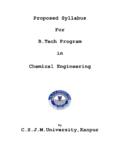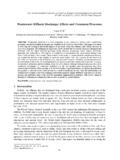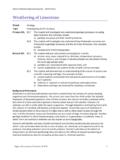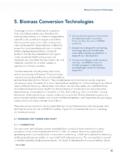Transcription of Statistical physics of self-replication
1 Statistical physics of self -replicationJeremy L. England Citation: J. Chem. Phys. 139, 121923 (2013); doi: View online: View Table of Contents: Published by the AIP Publishing LLC. Additional information on J. Chem. Homepage: Journal Information: Top downloads: Information for Authors: Downloaded 21 Aug 2013 to This article is copyrighted as indicated in the abstract. Reuse of AIP content is subject to the terms at: JOURNAL OF chemical PHYSICS139, 121923 (2013) Statistical physics of self -replicationJeremy L.
2 EnglandDepartment of physics , Massachusetts Institute of Technology, Building 6C, 77 Massachusetts Avenue,Cambridge, Massachusetts 02139, USA(Received 28 April 2013; accepted 1 August 2013; published online 21 August 2013) self - replication is a capacity common to every species of living thing, and simple physical intuitiondictates that such a process must invariably be fueled by the production of entropy. Here, we un-dertake to make this intuition rigorous and quantitative by deriving a lower bound for the amountof heat that is produced during a process of self - replication in a system coupled to a thermal find that the minimum value for the physically allowed rate of heat production is determined bythe growth rate, internal entropy, and durability of the replicator, and we discuss the implicationsof this finding for bacterial cell division.
3 As well as for the pre-biotic emergence of self -replicatingnucleic acids. 2013 Author(s). All article content, except where otherwise noted, is licensed undera Creative Commons Attribution Unported License.[ ]INTRODUCTIONE very species of living thing can make a copy of it- self by exchanging energy and matter with its feature common to all such examples of spontaneous self - replication is their Statistical irreversibility: clearly, itis much more likely that one bacterium should turn into twothan that two should somehow spontaneously revert back intoone.
4 From the standpoint of physics , this observation containsan intriguing hint of how the properties of self -replicatorsmust be constrained by thermodynamic laws, which dictatethat irreversibility is always accompanied by an increase ofentropy. Nevertheless, it has long been considered challeng-ing to speak in universal terms about the Statistical physics ofliving systems because they invariably operate very far fromthermodynamic equilibrium, and therefore need not obey asimple Boltzmann probability distribution over microscopicarrangements.
5 Faced with such unconstrained diversity of or-ganization, it is quite reasonable to worry that the particularmechanistic complexity of each given process of biologicalself- replication might overwhelm our ability to say much interms of a general the beginnings of a way forward, we should considera system of fixed particle numberNand volumeVin contactwith a heat bath of inverse temperature . If we give labels tothe microstates of this systemi,j, etc. and associate energiesEi,Ej, etc., respectively with each such microstate, then theunderlying time-reversal symmetry of Hamiltonian dynamicstells us that the following detailed balance relation holds atthermal equilibrium:1e EiZ( ) (i j; )=e EjZ( ) (j i ; ).
6 (1)Here,i is the momentum-reversed partner ofi, andZ( )is the canonical partition function of the system. The transi-tion matrix element (i j; ) is the conditional probabilitythat the system is found to be in microstatejat timet= >0 given that it started off in microstateiat an earlier timet=0. Thus, the above relation states that when the system hasrelaxed to thermal equilibrium and achieved a Boltzmann dis-tribution over microstates (p(i)=e EiZ( )), the probability cur-rents connectingitojin the forward and time-reversed direc-tions are comes from recognizing that the heat expelledinto the bath over a transition fromitojis given by Qi j=Ei Ej, and moreover that the quantity Qi jis theamount by which the entropy of the heat bath changes overthe course of this transition.
7 Thus, we may write (j i ; ) (i j; )=exp[ Si jbath].(2)Equation(2)sets up a microscopically detailed relationshipbetween the irreversibility of a transition (that is, how muchmore likely it is to happen in the forward direction than inthe reverse direction) and the amount entropy is increased inthe surroundings over the course of the forward , it should be stressed that while this result is de-rived from a statement of detailed balance (which only holdsat equilibrium) it is itself valid for any transition between twomicrostates, and thus applies to the relaxation dynamics ofundriven systems arbitrarily far from principal aim of this work is to show that the mi-croscopically detailed, quantitative relationship between ir-reversibility and entropy production illustrated above hassignificant, general thermodynamic consequences for far-from-equilibrium, macroscopic processes such as biologicalself- replication .
8 Building on past results in nonequilibriumstatistical mechanics,2we will first derive a generalizationof the Second Law of Thermodynamics for macroscopic ir-reversible processes. Subsequently, we will use this resultto demonstrate a lower bound on the heat output of a self -replicator in terms of its size, growth rate, internal entropy,and durability. We will furthermore show, through analy-sis of empirical data, that this bound operates on a scalerelevant to the functioning of real microorganisms and (12)/121923/8 Author(s) 2013139, 121923-1 Downloaded 21 Aug 2013 to This article is copyrighted as indicated in the abstract.
9 Reuse of AIP content is subject to the terms at: Jeremy L. EnglandJ. Chem. , 121923 (2013)MACROSCOPIC IRREVERSIBILITYOur goal is to determine thermodynamic constraints ona macroscopic transition between two arbitrarily complexcoarse-grained states. To do so, we have to think first abouthow probability, heat, and entropy are related at the mi-croscopic level. Equation(2)established such a relation-ship in one special case, but the linkage turns out to be farmore general, for it has been shown2that for all heat bath-coupled, time-symmetrically driven nonequilibrium systemswhose dynamics are dominated by diffusive motions that lackany sense of ballistic inertia, any trajectory starting atx(0),and going through microstatesx(t) over time obeys Q[x(t)]=ln[ [x(t)] [x( t)]].
10 (3)Here, 1/Tsets the temperatureTof the bath in naturalunits, [x(t)] is the probability of the trajectoryx(t)givenx(0),and Qis the heat released into the bath over the course ofx(t). This formula captures the essential microscopic relation-ship between heat and irreversibility: the more likely a for-ward trajectory is than its time-reverse, the more the entropyof the universe is increased through the exhaustion of heat intothe surrounding bath. Furthermore, it should be emphasizedthat this result holds for systems subject to time-symmetricexternal driving fields.







